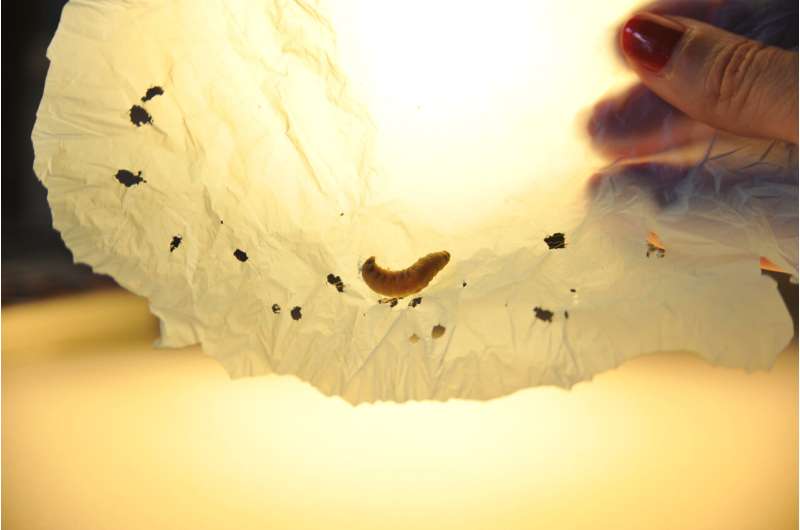Wax worm saliva contains enzymes capable of breaking down plastics

A team of CSIC researchers has discovered that wax worm saliva degrades plastic; a discovery with numerous applications for treating or recycling plastic waste. Back in 2017, the team discovered that this worm species (the lepidopteran Galleria mellonella) is able to break down plastic (polyethylene), and now they have discovered just how it does this: its saliva contains enzymes (pertaining to the phenol oxidase family) that can rapidly set off polyethylene degradation at room temperature. These enzymes are the first and only known enzymes capable of degrading polyethylene plastic without requiring pre-treatment, according to Federica Bertocchini, a CSIC researcher at the CIB-CSIC (Centre for Biological Research) who led the study. The results of the work, pending review, have been published in preprint in the BioRxiv online archive.
"For plastic to degrade, oxygen must penetrate the polymer (the plastic molecule). This is the first step in oxidation, which is usually a result of exposure to sunlight or high temperatures, and represents a bottleneck that slows down the degradation of plastics like polyethylene, one of the most resistant polymers," explains Bertocchini. "That is why, under normal environmental conditions, plastic takes months or even years to degrade," she adds.
"Now we have found out that enzymes in the wax worm's saliva perform this crucial step: they oxidize the plastic. This means they can overcome the bottleneck in the plastic degradation process and accelerate its decomposition," she adds.
Polyethylene is one of the toughest and most widely used plastics. Together with polypropylene and polystyrene, it makes up 70% of total plastic production. Plastic pollution poses a threat to the planet's health and environment, so it is urgent to find solutions to tackle the plastic waste problem. One of the most promising research areas with the greatest potential is the biological degradation of plastics. This process is known as biodegradation and is associated with microorganisms such as bacteria and fungi. However, to date, only a handful of microorganisms are known to break down the tough plastic polymers forming polyethylene. What is more, in most cases, aggressive pre-treatment is needed to guarantee oxidation and thus enable the micro-organisms to exert some effect (albeit slow) on the plastic.
Plastic-eating worms
A few years ago, a new field of research opened up with the discovery that some insect species of the Lepidoptera and Coleoptera orders are able to degrade polyethylene and polystyrene. "In our lab, we discovered the insect that seems to be the fastest of all: the larvae of the lepidopteran Galleria mellonella, commonly known as the wax worm," says Bertocchini. "These larvae are able to oxidize and break down the polymers in the plastic really quickly" (after just one hour's exposure).
"In recent years, efforts have been made to find out how these insects manage to do this. Numerous studies have focused on the microorganisms inhabiting the digestive system of these worms, based on the assumption that the worms can use plastic as food and that its degradation would be the result of their metabolic activity and digestive processes," remarks the researcher. "But this assumption is highly questionable so, from the start, our research has focused on the worm's oral cavity," she explains.
"We have scrutinized the wax worm's behavior when it comes into contact with polyethylene and found that the enzymes present in the worm's saliva (i.e., the liquid inside the insect's mouth) can degrade polyethylene," Bertocchini tells us. "On coming into contact with saliva, the polymer oxidizes and depolymerizes within a few hours. We have identified degraded residues that form in the presence of the worm's saliva," she says.
Furthermore, the researchers have analyzed the saliva using electron microscopy and observed a high protein content. "We have isolated two enzymes from the saliva that can reproduce the oxidation produced by the saliva as a whole," explains the researcher. These two proteins, called Demetra and Ceres, belong to the family of phenol oxidase enzymes.
"We found that the Demetra enzyme had a significant effect on polyethylene, leaving marks (small craters) on the surface of the plastic, visible to the naked eye; this effect was also confirmed by the appearance of degradation products formed after exposure of the polyethylene to this enzyme. The Ceres enzyme oxidizes the polymer too, but does not leave visible marks, suggesting that the two enzymes have a different effect on polyethylene," she sums up.
How phenol oxidase enzymes work
Phenols are molecules used by plants to defend themselves against potential enemies, such as insect larvae. Therefore, insects could produce phenol oxidase enzymes as a way to oxidize plant phenols, and thus neutralize them, meaning they could feed safely on the plants. Phenols are also present in many plastic additives, which could make them targets for these enzymes and create the necessary conditions for oxidation and depolymerisation of the plastic. "So far, this is just speculation and further experiments will be needed to investigate the enzyme's mechanisms of action in depth," researchers warn.
An even more interesting question is how wax worms have acquired this ability. Researchers speculate that it could be due to an evolutionary process. Wax worms feed on hive wax and pollen from a wide variety of plant species. Considering that hive wax is full of phenols, this type of enzyme would be very useful to these bugs. Indirectly, this would explain why wax worms can break down polyethylene. However, so far this theory is only speculation and we must carry out more research combining insect biology with biotechnology.
More information: Federica Bertocchini et al, Wax worm saliva and the enzymes therein are the key to polyethylene degradation by Galleria mellonella, BioRxiv (2022) DOI: 10.1101/2022.04.08.487620v1
Provided by Spanish National Research Council (CSIC)





















